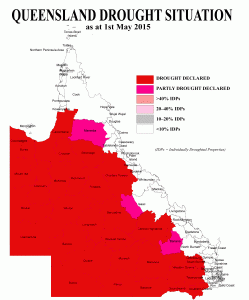A Queensland Government move to lift maximum Drought Relief Assistance Scheme (DRAS) support payments from $30,000 to $40,000 per annum will allow some of the hardest hit farmers to seek further assistance towards the costs of fodder and water freight and emergency water infrastructure for stock, according to AgForce.
The assistance is available for property owners who are in their third and/or subsequent year of drought, and who havean approved Drought Management Plan in place.
Local government areas now demed to be in the third year of drought are Boulia, Cloncurry, Croydon, Diamantina, Etheridge, Flinders, McKinlay, Murweh, Paroo, Richmond, Mt Isa.
Shires that will enter a third year of drought later in the year according to Queensland Government assessments are Balonne, Barcaldine (part),Barcoo, Blackall, Central Highlands (part), Charters Towers (part), Isaac (part), Longreach (part), Maranoa (part), Quilpie, Winton, Woorabinda (part).
“We spoke to the State Government about broadly increasing the cap from $30,000 per farm to $40,000 following another recent failed wet season, and to their credit they’ve listened and acted,” AgForce president Grant Maudsley said.
“This drought clearly exceeds what we can expect our primary producers to manage as this is the third or even fourth consecutive year of these severe conditions in many areas.
“Just this week it was announced more than 80 per cent of the state is now officially drought declared to make this the highest proportion of the Queensland land mass simultaneously drought affected.
“There is little doubt an event of this magnitude risks crushing the income and spirits in country Queensland communities.”
Mr Maudsley said initial results from a recent survey of AgForce members showed:
- 50 per cent of respondents had experienced up to a halving of their gross annual income, while 17 per cent reported an income reduction greater than three-quarters;
- 37 per cent had seen debt increase by 25 per cent, while 22 per cent had experienced debt increases between 26-50 per cent;
- 85 per cent of respondents were running less than three-quarters of their long-term stock carrying capacity and one-in-five carrying less than a quarter;
- One in seven has less than 10 per cent of their potential surface water supply;
- 65 per cent rated this drought worse financially than previous drought events while 59 per cent rated it worst personally and 46 per cent rate rated it worse environmentally.
About three out of five respondents had received or previously used some state or federal government assistance, either financial or personal, with water infrastructure subsidies and financial counseling particularly well received.
Mr Maudsley said primary producers did not expect handouts from government but a review of existing measures was now critical.
“Some much needed assistance is getting out to people suffering in this drought and governments are aware of the need,” he said.
“While all governments are recognising the severity of conditions in regional Queensland, AgForce will continue to push to improve the availability of assistance so it delivers real benefits to all those in most need.”
Queensland agriculture minister Bill Byrne said the increase is effective for the 2014-15 financial year and will remain in place as long as the current drought continues.
“The last time we lifted the cap on annual DRAS assistance was in December 2006, five years into the Millennium Drought,” Mr Byrne said.
“After three years of failed wet seasons, just over 80 per cent of the state is now drought declared.
“We can’t make it rain, but we can provide support to help our struggling producers to maintain their flocks and herds until this persistent dry spell finally breaks.
“The additional drought funding will assist livestock owners with the rising costs of transporting fodder and water supplies over increasing distances. As the Emergency Water Rebate is a part of DRAS, the increase also applies to water infrastructure eligible for the rebate.
“There are 11 local government areas in northern and western Queensland that have now entered the third year of being drought declared. As we are now in the dry season and unlikely to receive drought breaking rain, another 12 local government areas are likely to enter their third year of drought by the end of this calendar year.
“More than 1300 primary producers have applied for DRAS across the ten shires that were first drought declared in 2013.”
The latest declarations have taken the number of drought-declared councils to 33 with another three part declared, as well as 63 Individually Droughted Properties in a further five council areas. Areas of south east Queensland, Wide Bay and the Burnett, where conditions have improved, have had their drought status revoked, and will now be able to access returning from agistment and restocking freight subsidies through DRAS to aid with drought recovery.
Source: AgForce/Queensland Government. Producers wanting to apply for DRAS assistance, including the Emergency Water Infrastructure Rebate should contact the Department of Agriculture and Fisheries on 13 25 23 or access to DRAS claim forms and IDP applications can be foundat www.daff.qld.gov.au. Maps of drought declared areas and boundary descriptions can be found at www.longpaddock.qld.gov.au

